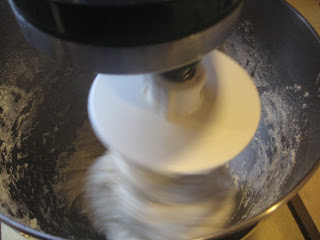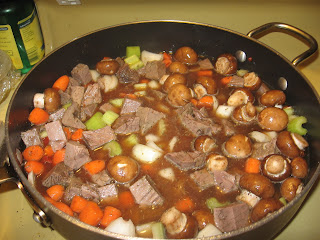Do you have a meal you remember fondly
from your childhood? Something your Mom, Grandmother, or Aunt made?
I sure do. My favorite meal growing up was my mother's chicken soup
with matzah balls (we called them alkies) and her egg bread. There
was no greater treat than walking into a house full of those smells.
I grew up fascinated watching her make the dough and form the bread.
I wish I could tell you her Challah bread recipe had been handed down
from her mother, who learned it from her mother, etc. She did learn
to make the soup that way, but not the bread. She took a cookbook
out of the library when she was a young bride and found this recipe.
She was never able to remember the name of the cookbook and never saw
it again. She loved all of the recipes she tried. Thank goodness
she wrote this one down. I wish I could credit the author, but this
was about 50 years ago. I honestly don't know how much is the
original recipe and method and how much my mother may have tweaked it
over the years. All I know is that it is delicious!
This recipe is laid out in steps.
First you proof the yeast, then you mix in some dry ingredients, then
the eggs, butter and the rest of the flour go into the bowl. The
original recipe makes 4 loaves of bread. I often cut it in half
because my KitchenAid mixer isn't large enough to do the full recipe.
I will mix up the full recipe,in a huge bowl I have, if I want to
put some loaves in the freezer.
Since I use instant yeast and my dough
hook, I just put in the dry ingredients from steps one and two, and
then add the water from both steps. Then I add the rest of the
ingredients from step 3.
For today I cut this recipe in half.
Step 1 - Combine and let stand:
1 cup warm water
2 teaspoons sugar½ teaspoon ground ginger
4 pkgs (2 ¼ tsp each) dry yeast
Step 2 - In another bowl mix:
4 cups flour
1 cup dry milk (optional)2 cups warm water
1/3 cup sugar
Step 3 - Add yeast mix to flour mix and
beat. Add the following:
½ cup soft butter
2 teaspoons salt4 eggs
4 cups flour
Knead the mixture with 1 cup or more
flour until smooth and elastic, about 6 minutes. Place in greased
bowl and cover. Allow to rise until doubled. 1 hour on the counter,
or using the microwave rise method. I've seen this dough rise in 20
minutes if the conditions are right.
Punch the dough down and form into 2
large or 4 small braided loaves. Since I cut this recipe in half, for one loaf of Challah and one batch of sticky buns, I cut the dough in half and cut one half into 3 pieces to use for braids.
I find my braids look nicer if I start braiding in the middle instead of at one end.
Move the loaf to a cookie sheet, cover and allow to rise a second time.
Brush with egg yolk mixed with a little water. You can sprinkle the loaves with poppy seeds or sesame seeds. Bake at 375 degrees F for 30 minutes or until golden brown. This Challah recipe continues to rise in the oven. Not all breads will do this.
If you are keeping Kosher and want to
serve this with meat, leave out the dry milk and use margarine.
It is traditional to braid this dough,
but you can form it into regular loaves, rolls or whatever shape you
want. It holds a shape very well. I love to use this dough to make
sticky buns. I used half of it today to do that very thing.
To make sticky buns you roll one quarter (half of what I made)
of the above recipe into a large rectangle. I use my cutting board
as a guide, but you want it to be about 12 inches by 18 inches.
Remember, when rolling out bread dough it helps to let the dough rest
for a minute or two here and there. The gluten will relax and it
won't spring back on you if you let it rest.
Spread softened butter
all over the dough and sprinkle with some white sugar, brown sugar
and cinnamon. I don't have specific measurements, but you don't want
too much of anything. Otherwise they will just be sloppy. I
probably use about 1/3 cup of each sugar and about 4 to 5 tablespoons
of butter. I use about 2 teaspoons of cinnamon. If you like
chocolate chips or raisins, sprinkle some of them on now.
Then roll
the dough up starting with a long end. Cut the dough in half, then
cut each half in half. Cut each quarter into 3 pieces. You can put
them straight into a pan if you just want cinnamon buns. If you want
sticky buns, mix the following and pour it into the bottom of the pan
before placing the buns on top.
Mix together in a bowl:
2 tablespoons corn syrup
¾ cup brown sugar, packed6 tablespoons melted butter
chopped pecans, if you have them and like them.
Allow the sticky buns to rise until
doubled and bake in a 350 to 375 degree oven for about 30 minutes, or
until golden brown.
I wish you could smell my house right
now.
























































